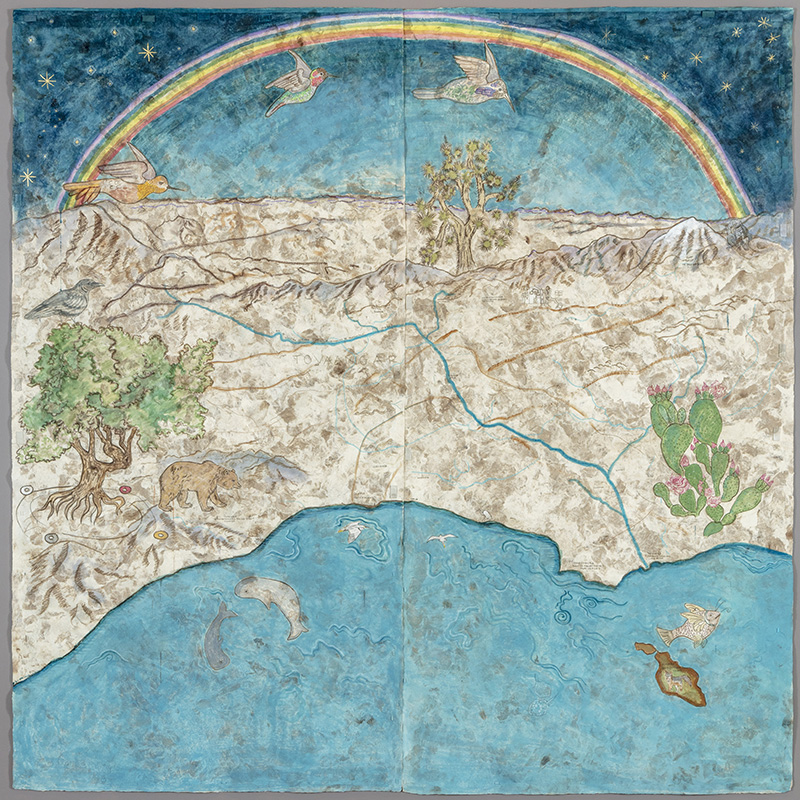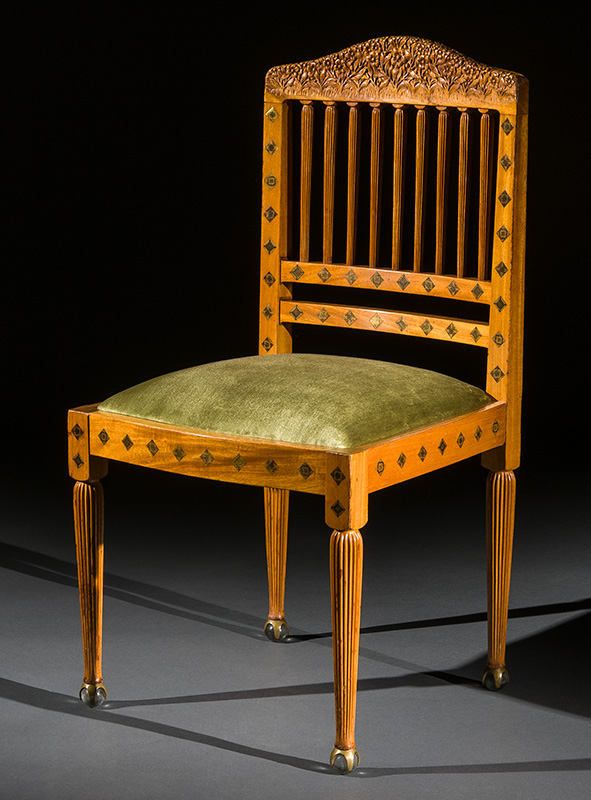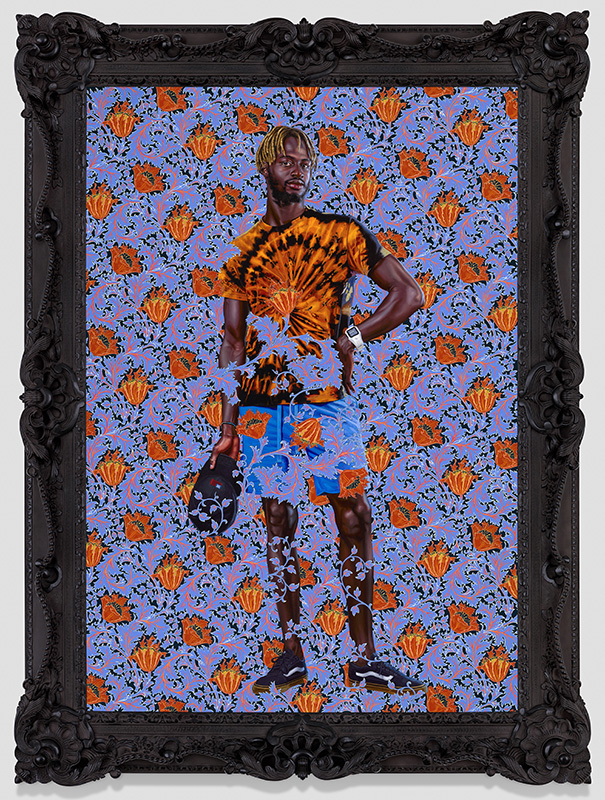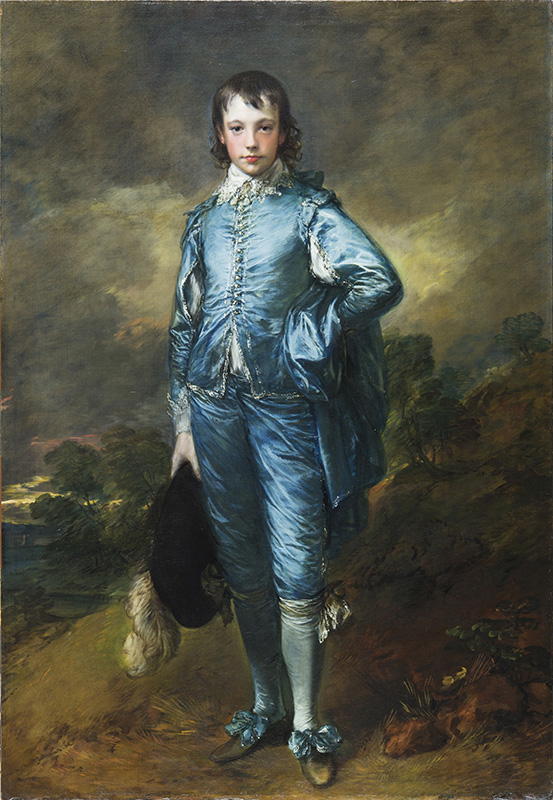“Borderlands” at The Huntington
by Dennis Carr and Yinshi Lerman-Tan
When Trust members entered the first gallery of the new installation, “Borderlands,” at The Huntington Library, Art Museum, and Botanical Gardens in early December, they were confronted with an 8-foot-by-8-foot watercolor map of Los Angeles by the contemporary LA-based artist Sandy Rodriguez. YOU ARE HERE —Tovaangar / El Pueblo de Nuestra Señora la Reina de los Ángeles de Porciúncula / Los Angeles (figure 1) does not feature the familiar network of freeways that usually characterize the cartography of LA, but rather the psychic, historic, and natural placemakers of the city. Locations are identified by their English, Spanish, and Tongva names—revealing a layered, multilingual history of the city 500 years after the Spanish invasion and conquest of Mexico. Images of native plants and animals populate the land, rendered in a loose style drawn from early colonial painted manuscripts from Mexico. Rodriguez also used locally sourced pigments and colorants, derived from mineral and organic sources, and 23-karat gold leaf applied to amate paper, a native fig-bark paper that was traditionally used in Mexico.
Rodriguez’s work provides a visual introduction to the reinstallation of the American art galleries, which reimagines the history of American art through the metaphor of borderlands. The history of the United States has been defined by a series of cultural encounters along a constantly shifting, ever-evolving border. From the earliest period of European settlement in the 16th and 17th centuries, to the westward expansion movements of the 19th century to today, the borderlands of the Americas were zones of cultural contact and exchange. They were places where cultures met, and where the objects created or interchanged reflected the complex multiracial, multiethnic, multilingual, and multicultural contexts in which they were made. Objects in the exhibition highlight notions of place, histories of migration, and representation of the landscape. In considering these themes, the exhibition centers Indigenous histories and the close relationship between art, land, and ecology.
The exhibition delves into historic material drawn from The Huntington’s permanent collection. The exhibition considers works of 19th-century painting and material culture through the idea of borders and border-crossing. For example, a gallery of 19th-century landscape painting, including works by Albert Bierstadt, Frederic Edwin Church, and the Mexican painter José María Velasco, reveal how landscape painters crossed the hemisphere from the Arctic to South America, rendering the ecology and land of the Americas. Also featured is a new acquisition, Thomas Cole’s 1839 monumental landscape Portage of Falls on the Genesee (figure 2), which speaks to the land-centered conception of nationhood in the 19th-century, a period of rising development and industrialization.
Another gallery considers how the transatlantic border crossing of American artists in the late 19th and early 20th centuries—from Cecilia Beaux and Mary Cassatt to Thomas Eakins and John Singer Sargent—exposed them to global influences, including the European avant-garde and Orientalist subjects from the real or imagined Asia and the Middle East. The installation also features works by Herter Brothers and Louis Comfort Tiffany (figure 3) on a background of William Morris wallpaper that addresses this theme. Sitting nearby is a new acquisition: a painting by Lockwood de Forest featuring an elaborately carved frame made by the Ahmedabad Wood Carving Company he developed in India.
The exhibition also explores personal borders, boundaries, and identity, highlighting artists who broke barriers in the 19th century. For example, Harriet Goodhue Hosmer’s monumental marble sculpture Zenobia in Chains is a focal point (figure 4). Hosmer’s life, like that of the ancient queen she sculpted, was defined by rebellion. In her 20s, Hosmer moved to Rome to become a professional sculptor, finding support from a circle of creative expatriate women who broke 19th-century social expectations by living alone, pursuing artistic careers, and, as was the case for Hosmer, being open about their queer identity. Despite challenges to her skill by male critics, she became one of the most successful American sculptors of her era.
As the galleries of American art sit in the larger context of The Huntington’s botanical gardens and collections, the exhibition creates a close dialogue between galleries and the natural world. Enrique Martínez Celaya’s mural on glass, There-Bound, painted on the massive glass façade of the building, depicts migratory birds in flight along with lines that echo Los Angeles freeways and the migratory flight patterns of birds, suggesting that human borders embody the wildlife that transcend them. An education space called “Art and Color” focuses on the links between art and the natural world, exploring the Indigenous knowledge and uses of botanical, mineral, and animal sources to produce pigments for textiles and artmaking. For example, didactics and displays explore the deep red pigment derived from cochineal insects that are endemic to Mexico and parts of South America, which reached as far as Europe and Asia through the global export trade routes of the 16th century.
“Borderlands” dovetails with a range of initiatives and projects at The Huntington in 2021 that Trust members encountered during their visit. In the art museum, Kehinde Wiley’s new commission, A Portrait of a Young Gentleman (figure 5), was unveiled in October, as a response to Thomas Gainsborough’s 1770 The Blue Boy (figure 6). In the Japanese Garden, a recently acquired 17th-century Magistrate’s House from Japan’s Kagawa Prefecture is being rebuilt on the grounds as the Japanese Heritage House, following the successful opening of the newly expanded Chinese Garden last year. “Borderlands” adds to these projects, as well as a number of recent acquisitions in American art, to broaden our treatment of American art through a global and hemispheric perspective, and with an interdisciplinary lens that spans our diverse collections.
Dennis Carr is the Virginia Steele Scott Chief Curator of American Art and Yinshi Lerman-Tan is the Bradford and Christine Mishler Associate Curator of American Art at The Huntington. Decorative Arts Trust members visited The Huntington for curator-led tours in December 2021.
A print version of this article was published in The Magazine of the Decorative Arts Trust, one of our most popular member benefits. Join today!






